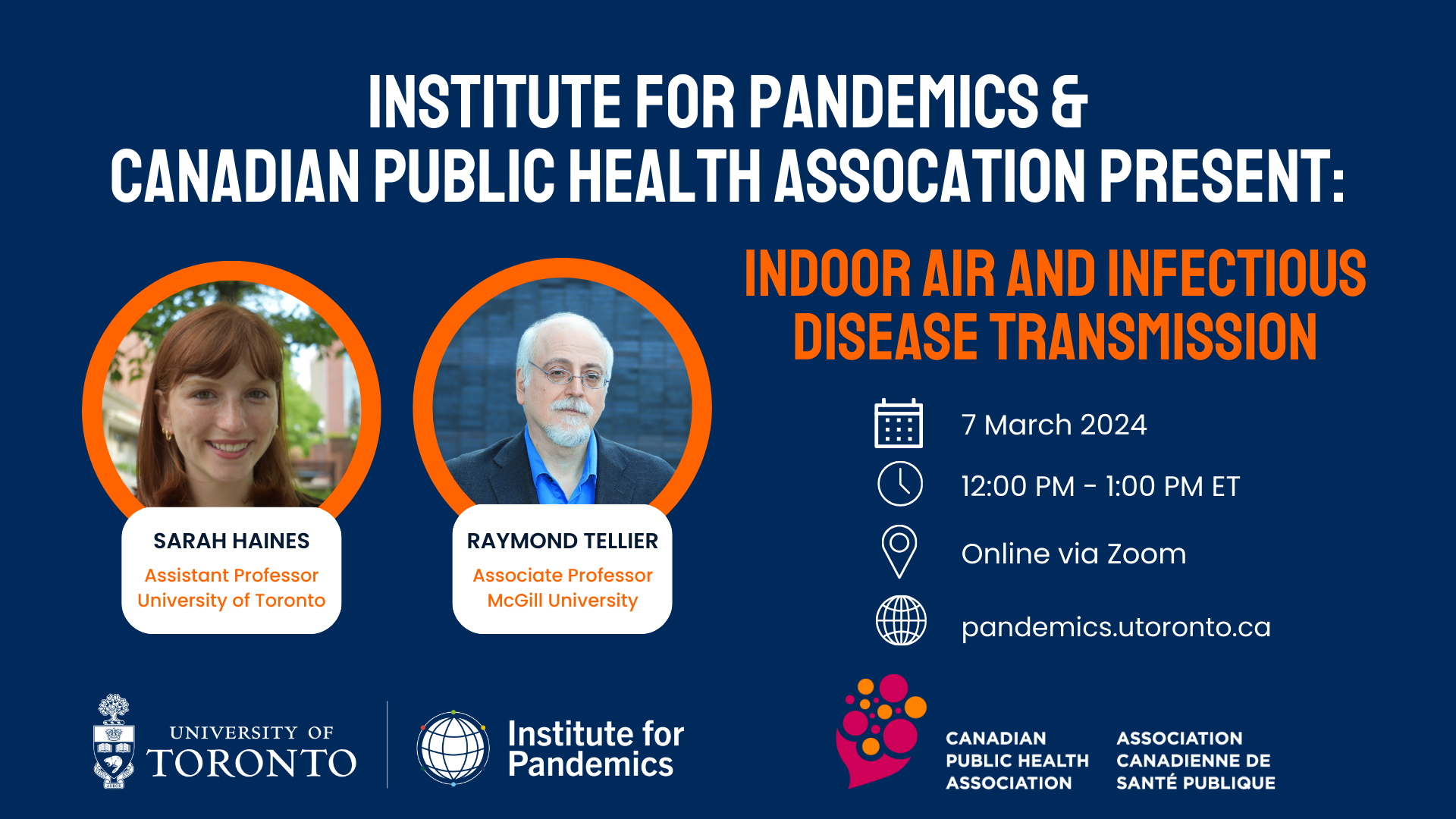
Indoor air and infectious disease transmission
Event details:
The Institute for Pandemics (IfP) in collaboration with the Canadian Public Health Association presented a webinar for public health professionals to hear the latest research on indoor air transmission of infectious diseases and strategies to reduce exposure. This webinar is a preview to the symposium, “Something in the air: Towards a new understanding of aerosols and respiratory disease transmission”, that will be presented at Public Health 2024 in Halifax this April.
Presentation Topics
Aerosols and Pandemics
Raymond Tellier introduced the concept and definition of respiratory bioaerosols, and review some of the abundant scientific evidence supporting an important role for aerosol transmission of influenza A virus and SARs-CoV-2 virus, 2 agents with a proven pandemic capacity.
Preventing indoor air exposures through engineered strategies
Sarah Haines presented her recent work on portable air cleaners to detect SARs-CoV-2 as well as identifying ventilation and other strategies that may be beneficial in reducing viral exposure.
Read the presenters' responses to the questions submitted by attendees HERE.
About the presenters
Dr. Raymond Tellier obtained a BSc in Physics from Université de Montréal and a MSc in Mathematics from McGill University. He then obtained a MD degree and a MSc in Microbiology from Université de Sherbrooke. He did his internship at the Royal Victoria Hospital, McGill University and his Residency in Medical Microbiology at the University of Toronto. He then did postdoctoral studies at the National Institutes of Health in the Hepatitis Viruses Section, NIAID.
Dr. Tellier worked as a Medical Microbiologist for 12 years at the Hospital for Sick Children and was an Associate Professor at the University of Toronto. He was Medical Microbiologist for 10 years at the Laboratory for Public Health of Alberta in Calgary and member of the Faculty at the Cumming School of Medicine of the University of Calgary, as Associate Professor and then Professor. He is currently Medical Microbiologist at the McGill University Health Centre (MUHC), Site Chief at the Microbiology Laboratory (Glen site, MUHC) and Associate Professor at the Division of Infectious Diseases, Dept. of Medicine of McGill University.
Dr. Tellier has published more than 125 peer-reviewed scientific articles. His research interests include molecular diagnostic methods in virology and medical microbiology, hepatitis viruses, respiratory viruses, infectious aerosols, opportunistic viral infections, viral infections of the central nervous system and emerging viruses.

Dr. Sarah Haines is an Assistant Professor in the Department of Civil & Mineral Engineering and is the Director of the Indoor Microbiology and Environmental Exposures (IMEE) Lab. Dr. Haines holds a BS in Environmental Engineering and an MS and PhD in Environmental Science from The Ohio State University. She is also the Director of the From Harvest to House Program which aims to identify pathways for housing self-sufficiency in northern First Nations Communities, addressing mould and moisture issues.
Dr. Haines’ interdisciplinary research integrates building science, engineering, and microbiology to analyze connections between the built environment and human health. She uses cutting-edge microbiology techniques such as next-generation sequencing, metatranscriptomics, and bioinformatics to evaluate the indoor microbiome. Her work aids in understanding indoor exposures from microorganisms, viruses and chemicals, providing for a cleaner and sustainable indoor environment, particularly for our most vulnerable communities.

